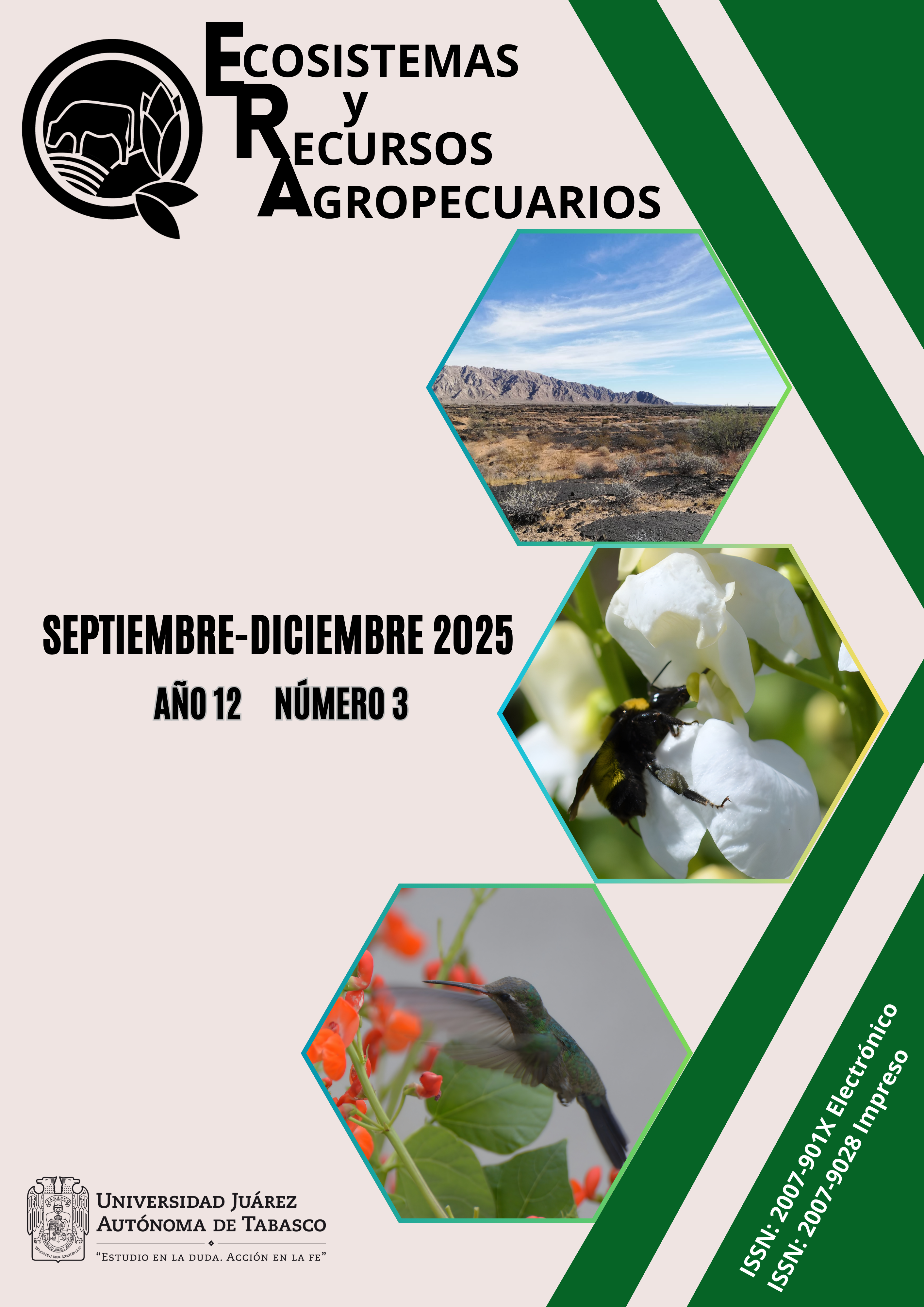Reporte de Meloidogyne incognita afectando higueras (Ficus carica L)
DOI:
https://doi.org/10.19136/era.a12n3.4305Palabras clave:
Ficus carica L, Nematodo agallador, Primer reporte, fitopatógeno, fito nematodosResumen
En enero de 2023 se detectaron síntomas de debilitamiento en higueras (Ficus carica) en una huerta comercial de Ramos Arizpe, Coahuila, México, incluyendo clorosis, bajo crecimiento y formación de agallas en raíces. El objetivo fue identificar los nematodos asociados a estos daños. Se recolectaron muestras de suelo y raíces, en las que se identificó a Meloidogyne incognita en el 55.5 % de las raíces analizadas, mediante el análisis del patrón perineal de hembras, lo que representa el primer registro de esta especie en higueras tanto en Coahuila como en México. Además, se detectaron nematodos pertenecientes a los géneros Rhabditis, Aphelenchoides, Dorylaimus, Tylenchus, Psylenchus y Helicotylenchus. Este hallazgo contribuye a que los productores reconozcan a M. incognita como un posible riesgo fitosanitario en higueras, y se incluya en sus programas de monitoreo y manejo integrado.
Descargas
Referencias
Askary TH, Gani M, Wani AR (2021) Nematodes associated with stone fruits and their management strategies. In: Mir MM, Iqbal U, Mir SA (eds) Production technology of stone fruits. Springer. Singapore. pp. 423-436. https://doi.org/10.1007/978-981-15-8920-1_16
Ayuso M, Carpena M, Taofiq O, Albuquerque TG, Simal-Gandara J, Oliveira MBPP, Prieto MA, Ferreira ICFR, Barros L (2022) Fig “Ficus carica L.” and its by-products: A decade evidence of their health-promoting benefits towards the development of novel food formulations. Trends in Food Science and Technology 127: 1-13. https://doi.org/10.1016/j.tifs.2022.06.010
Beech E (2023) Ficus carica. The IUCN Red List of Threatened Species. https://dx.doi.org/10.2305/IUCN.UK.2023-1.RLTS.T63527A224496277.en
Bello A (1983) Nematodos patógenos de los árboles frutales. Boletín de Sanidad Vegetal 2(9): 133-165.
Cid-del-Prado VI (2009) Claves Taxonómicas y diagnosis de familias y géneros orden Tylenchida suborden: Tylenchina y Criconematina y orden Aphelenchida: suborden Aphelenchina: subfamilias Aphelenchoidinae y Rhadinaphelenchinae. http://nemaplex.ucdavis.edu/Courseinfo/Curso%20en%20Espanol/Claves%20de%20suborden% 20Tylenchina.pdf. Fecha de consulta: 8 de febrero 2023
Devran Z, Söğüt MA (2009) Distribution and identification of root-knot nematodes from Turkey. Jouurnal of Nematology 41(2): 128-133.
Eisenback JD, Hirschmann H, Sasser JN, Triantaphyllou AC (1983) Guía para la identificación de cuatro especies más comunes del nematodo agallador (Meloidogyne especies), con una clave pictórica. (Traducción de Carlos Sosa-Moss). International Meloidogyne Project. Raleigh, North Carolina, USA. 40p.
El-Shazly SM, Mustafa NS, El-Berry IM (2014) Evaluation of some fig cultivars grown under water stress conditions in newly reclaimed soils. Middle-East Journal of Scientific Research 21(8): 1167-1179.
Harzallah A, Bhouri AM, Amri Z, Soltana H, Hammami M (2016) Phytochemical content and antioxidant activity of different fruit parts juices of three figs (Ficus carica L.) varieties grown in Tunisia. Industrial Crops and Products 83: 255-267. https://doi.org/10.1016/j.indcrop.2015.12.043
Lima-Medina I, Somavilla L, Carneiro RMDG, Gomes CB (2013) Species of Meloidogyne associated with fig (ficus carica) and host weeds [espécies de Meloidogyne em figueira (ficus carica) e em plantas infestantes]. Nematropica 43(1): 56-62.
Lima-Medina I, Somavilla L, Dechechi RM, Carneiro G, Gomes CB (2013) Espécies de Meloidogyne em figueira (ficus carica) e em plantas infestantes. Nematropical 43(1): 56-62.
Lima-Medina I, Araujo-Lima E, Bravo-Portocarrero, RY, Cornejo-Condori, GB, Franco-Mariaca DV, Casa-Coila VH (2024) Phytoparasitic and free-living nematodes associated with the cultivation of Passiflora ligularis Juss. In the Sandia Valley, Puno Region, Peru. Bioagro 36(2): 193-202. https://doi.org/10.51372/bioagro362.7
Luc M, Sikora RA, Bridge J (2005) Plant parasitic nematodes in subtropical and tropical agriculture. 2nd Edition. CABI Publishing. Wallingford, Oxfordshire. pp. 468-470. https://doi.org/10.1079/9780851997278.0000
Mani M (2022) Pests and their management in fig. In: Rehman MMA, Abedin MZ, Reza M M (eds) The fig: Botany, production and uses. CABI Publishing. Wallingford, Oxfordshire, UK. pp. 735-745. https://doi.org/10.1007/978-981-19-0343-4_26
Macías H, Rivera M, Palomo M (2015) Acodo aéreo: Alternativa para la producción intensiva del higo desde el primer año de plantación en macrotúneles. Agrofaz 15(2): 81-89.
McSorley R (1981) Plant parasitic nematodes associated with tropical and sub-tropical fruits. Bulletin 823 of Agricultural experiment station institute of food and agricultural science. Gainesville, Florida, University of Florida USA. 51p.
Neal JC (1889) The root-knot disease of the peach, orange and other plants in Florida due to the work of Anguillula. Bulletin of the United States Bureau of Entomology USA, No. 20.31p.
Nicol JM, Turner SJ, Coyne DL, Nijs LD, Hockland S, Maafi ZT (2011) Current nematode threats to world agriculture. In: Jones J, Gheysen G, Fenoll C (eds) Genomics and molecular genetics of plant-nematode Interactions. Springer. Dordrecht. pp. 21-43. http://doi.10.1007/978-94-007-0434-3-2
Paredes-Tomás C, Luis-Pantoja M (2020) Interacciones entre nematodos fitoparásitos y bacterias fitopatógenas en los complejos de enfermedades. Citrifrut 37: 44-49.
Peraza-Padilla W, Rosales-Flores J, Esquivel-Hernández A, Hilje-Rodríguez I, Molina-Bravo R, Castillo-Castillo P (2013) Identificación morfológica, morfométrica y molecular de Meloidogyne incognita en higuera (Ficus carica L.) en Costa Rica. Agronomía Mesoamericana 24(2): 337-346. https://doi.org/10.15517/AM.V24I2.12533
Phani V, Khan MR, Dutta TK (2021) Plant-parasitic nematodes as a potential threat to protected agriculture: Current status and management options. Crop Protection 144: 105573. https://doi.org/10.1016/j.cropro.2021.105573
Romero B, Manlet G, Carrillo FA, Rojas CM, Hernández RJ, Duarte OJ (2019) Identificación y distribución de especies de Meloidogyne en Baja California Sur, México. Revista Mexicana de Ciencias Agrícolas 10(2): 337-349. http://doi: 10.29312/remexca.v10i2.1603
Rusinque L, Nóbrega F, Serra C, Inácio M (2022) The Northern Root-Knot Nematode Meloidogyne hapla: New Host Records in Portugal. Biology 11(11): 1567. https://doi.org/10.3390/biolog y11111567
Santos D, Abrantes I, Maleita C (2020) Ficus acrocarpa Bonsai “Tiger bark” Parasitized by the Root-Knot Nematode Meloidogyne javanica and the Spiral Nematode Helicotylenchus dihystera, a New Plant Host Record for Both Species. Plants 9(9): 1085. https://doi.org/10.3390/plants9091085
SEDER (2020) Programa de Higo 2020. Secretaría de Desarrollo Rural. https://seder.coahuila.gob.mx/higo.html. Fecha de consulta 05 de Julio 2024
SE (2024) Higos, frescos o secos. Secretaría de Economía. Data México. https://www.economia.gob.mx/datamexico/es/profile/product/figs-fresh-or-dried. Fecha de consulta 30 de junio de 2025.
SIAP (2024) Producción agrícola por estado. Sistema de Información Agroalimentaria y Pesquera-SAGARPA. https://www.gob.mx/siap. Fecha de consulta 05 de Julio 2024
Trap J, Ranoarisoa MP, Raharijaona S, Rabeharisoa L, Plassard C, Mayad EH, Bernard L, Becquer T, Blanchart E (2021) Agricultural practices modulate the beneficial activity of bacterial-feeding nematodes for plant growth and nutrition: evidence from an original intact soil core technique. Sustainability 13(13): 7181. https://doi.org/10.3390/su13137181
USDA (2020) Agricultural Research Service. Food Composition Databases. United States Department of Agriculture. https://ndb.nal.usda.gov/ndb/search/list. Fecha de consulta 05 de Julio 2023.
Zeng J, Zhang Z, Li M, Wu X, Zeng Y, Li Y (2018) Distribution and molecular identification of Meloidogyne spp. parasiting flue-cured tobacco in Yunnan, China. Plant Protection Science 54(3): 183-189.
Descargas
Publicado
Número
Sección
Licencia
Derechos de autor 2025 Ecosistemas y Recursos Agropecuarios

Esta obra está bajo una licencia internacional Creative Commons Atribución-NoComercial-SinDerivadas 4.0.
1. Política propuesta para revistas de acceso abierto
Los autores/as que publiquen en esta revista aceptan las siguientes condiciones:
1. Los autores/as conservan los derechos de autor y ceden a la revista el derecho de la primera publicación, con el trabajo registrado con la Licencia CC BY-NC-ND 4.0 Creative Commons Attribution-NonCommercial-NoDerivatives 4.0 Internacional de Creative Commons, que permite a terceros utilizar lo publicado siempre que mencionen la autoría del trabajo y a la primera publicación en esta revista.
2. Los autores/as pueden realizar otros acuerdos contractuales independientes y adicionales para la distribución no exclusiva de la versión del artículo publicado en esta revista (p. ej., incluirlo en un repositorio institucional o publicarlo en un libro) siempre que indiquen claramente que el trabajo se publicó por primera vez en esta revista.
3. Se permite y recomienda a los autores/as a publicar su trabajo en Internet (por ejemplo en páginas institucionales o personales) antes y durante el proceso de revisión y publicación, ya que puede conducir a intercambios productivos y a una mayor y más rápida difusión del trabajo publicado (vea The Effect of Open Access).
![]()
This work is licensed under CC BY-NC-ND 4.0


